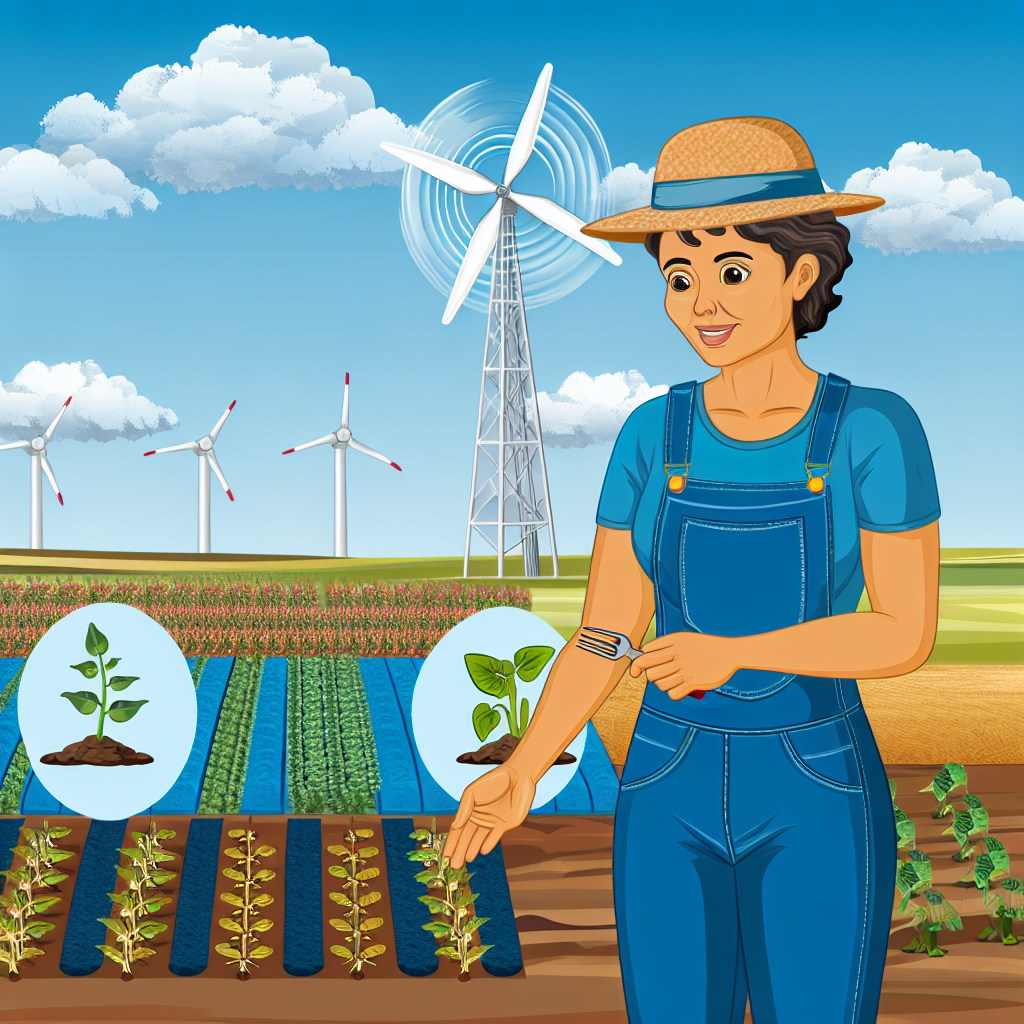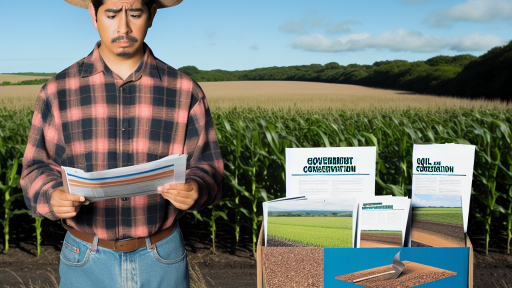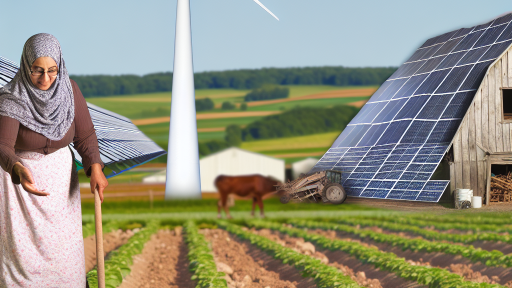Introduction to Climate-Smart Agriculture
Climate-smart agriculture (CSA) combines sustainable practices with innovation.
It aims to increase agricultural productivity while fostering resilience to climate change.
This approach addresses food security concerns in the face of environmental challenges.
Importance of Climate-Smart Agriculture
Climate-smart agriculture plays a pivotal role in conservation initiatives.
It enhances soil health and promotes biodiversity.
Moreover, it reduces greenhouse gas emissions from agricultural activities.
By adopting CSA, farmers can utilize resources more efficiently.
Adaptation and Resilience
Farmers face numerous climate-related challenges.
CSA equips them with tools to adapt to changing weather patterns.
For instance, improved water management strategies can mitigate drought impacts.
Additionally, diversified crop selection can enhance resilience against pests.
Collaboration and Knowledge Sharing
Successful CSA implementation requires collaboration among stakeholders.
Farmers, researchers, and policymakers must work together for best results.
Knowledge sharing ensures the dissemination of successful practices.
Additionally, local communities gain valuable insights from shared experiences.
Transform Your Agribusiness
Unlock your farm's potential with expert advice tailored to your needs. Get actionable steps that drive real results.
Get StartedInnovative Practices
Adopting innovative practices is crucial in climate-smart agriculture.
For example, agroforestry can enhance productivity while sequestering carbon.
Cover cropping protects soil from erosion and improves fertility.
Integrating technology also aids in precision agriculture.
Key Principles of Climate-Smart Agriculture
Sustainability
Climate-smart agriculture emphasizes sustainable practices.
These practices help maintain the land’s health over time.
Farmers adopt techniques that reduce resource depletion.
Examples include crop rotation and reduced tillage.
These methods enhance soil fertility and biodiversity.
Importantly, they also minimize greenhouse gas emissions.
Resilience
Resilience is crucial in the face of climate change.
This principle involves adapting farming systems to new conditions.
Farmers become more capable of managing extreme weather events.
For instance, drought-resistant crops can withstand dry spells.
Also, diversifying crops protects against market fluctuations.
Furthermore, sustainable water management ensures availability.
Mitigation
Climate-smart agriculture contributes to mitigation efforts.
This involves reducing the agricultural sector’s carbon footprint.
Farmers can implement practices that sequester carbon in soil.
Examples include agroforestry and cover cropping.
These practices not only improve soil health but absorb CO2.
In addition, precision farming optimizes resource use, further reducing emissions.
Integration
Integrating these principles is vital for success.
Collaboration between farmers and research institutions fosters innovation.
Showcase Your Farming Business
Publish your professional farming services profile on our blog for a one-time fee of $200 and reach a dedicated audience of farmers and agribusiness owners.
Publish Your ProfileLocal governments play a significant role in supporting initiatives.
They can provide resources and incentives for climate-smart practices.
Education and training help farmers adopt these techniques effectively.
Ultimately, a holistic approach leads to sustainable outcomes.
Overview of Conservation Initiatives Related to Climate-Smart Agriculture
Global Efforts in Climate-Smart Agriculture
Countries worldwide implement various climate-smart agriculture (CSA) initiatives.
These programs aim to improve food security and sustainability.
For example, several nations have embraced agroforestry practices.
Agroforestry integrates trees and crops to enhance biodiversity.
Community Engagement and Education
Community-based programs play a crucial role in CSA efforts.
Organizations often conduct workshops to educate farmers.
These sessions cover practices like cover cropping and crop rotation.
Moreover, local farmers receive practical training in sustainable techniques.
Adoption of Technology
Technology innovations have transformed agricultural practices worldwide.
For instance, precision agriculture improves resource management.
Farmers use tools like drones and sensors to monitor crop health.
This approach minimizes waste and enhances productivity.
Partnerships and Collaborations
Successful CSA initiatives often involve strong partnerships.
Governments, NGOs, and private sectors collaborate on projects.
These partnerships facilitate knowledge sharing and resource mobilization.
Additionally, they can secure funding for research and development.
Regional Examples of Climate-Smart Agriculture
In East Africa, projects implement sustainable land management practices.
Farmers receive training on soil conservation techniques.
Similarly, in Latin America, agroecological practices are gaining traction.
These practices promote ecosystem health and enhance crop resilience.
Impact Assessment and Monitoring
Monitoring and evaluation are essential for CSA initiatives.
Regular assessments help stakeholders understand the effectiveness of practices.
Data collection enables adjustments to strategies as needed.
Ultimately, this ensures long-term success and sustainability.
Gain More Insights: How Farmers Can Access Government Grants for Agricultural R&D Projects
Case Studies of Successful Climate-Smart Agriculture Practices
African Agroforestry Innovations
In East Africa, agroforestry practices have gained prominence.
Farmers integrate trees with crops to enhance biodiversity.
This method improves soil health and sequesters carbon.
Notably, the Green Belt Movement in Kenya has made significant strides.
This initiative promotes tree planting to combat deforestation.
As a result, local farmers witness improved yields.
GreenAgro’s Success in Latin America
In Brazil, the GreenAgro initiative focuses on sustainable farming practices.
This program encourages the use of cover crops and crop rotation.
These techniques help maintain soil health and reduce erosion.
Furthermore, farmers report increased resilience to climate shocks.
By adopting these practices, profits also rise significantly.
Showcase Your Farming Business
Publish your professional farming services profile on our blog for a one-time fee of $200 and reach a dedicated audience of farmers and agribusiness owners.
Publish Your ProfileAsia’s Integrated Farming Systems
In India, integrated farming systems are transforming local agriculture.
Farmers combine crop cultivation with livestock rearing.
This approach optimizes resource use and minimizes waste.
Moreover, the system enhances nutritional security for families.
Furthermore, community engagement fosters knowledge sharing.
This model highlights the need for local adaptation in agriculture.
Technological Innovations in North America
In the U.S., advanced technologies enhance climate-smart practices.
For example, precision agriculture tools help minimize resource usage.
Farmers can apply fertilizers and water more efficiently.
This strategy leads to significant reductions in environmental impact.
Likewise, the use of drones aids in monitoring crop health.
Overall, these technologies promote sustainable agricultural growth.
European Coastal Farming Adaptations
In the Netherlands, coastal farmers adapt to rising sea levels.
They employ innovative water management techniques.
For instance, floating farms are gaining attention in urban areas.
This approach utilizes aquaponics to combine fish and plant farming.
As a result, it maximizes space and conserves water resources.
Such initiatives showcase resilience against environmental changes.
See Related Content: Maximizing Agricultural Research and Development Funding: Tips for Farmers
The Role of Technology and Innovation in Enhancing Climate-Smart Agriculture
Innovative Agricultural Practices
New agricultural practices leverage technology to improve farm efficiency.
For example, precision farming uses data analytics to optimize crop yields.
This method minimizes waste and ensures resource conservation.
Additionally, organic farming techniques focus on sustainability and soil health.
Farmers adopt crop rotation and diversification to enhance ecological resilience.
Digital Tools for Monitoring and Data Collection
Technology provides digital tools for effective monitoring of agricultural activities.
Drone technology offers real-time aerial data for assessing crop health.
Moreover, soil sensors help farmers understand moisture levels accurately.
These tools assist in making informed decisions about planting and irrigation.
Climate Resilience through Genetic Innovation
Genetic engineering enhances crop resilience to climate change effects.
Scientists develop drought-resistant varieties to withstand extreme weather.
This innovation allows farmers to maintain productivity under challenging conditions.
Furthermore, bioengineering targets pest resistance, reducing pesticide dependence.
Efficient Resource Management
Smart irrigation systems optimize water usage in farming operations.
These systems adapt to weather patterns and soil moisture levels.
As a result, farmers conserve water while ensuring optimal crop growth.
Additionally, renewable energy sources promote sustainable farming practices.
Solar panels and wind turbines support farming operations with clean energy.
Collaborative Approaches and Knowledge Sharing
Technology facilitates collaboration among farmers and researchers.
Online platforms enable the sharing of best practices and innovations.
Farmers gain insights into climate-smart techniques from each other.
Showcase Your Farming Business
Publish your professional farming services profile on our blog for a one-time fee of $200 and reach a dedicated audience of farmers and agribusiness owners.
Publish Your ProfileThis collective knowledge enhances overall agricultural productivity.
Adoption of Sustainable Supply Chains
Technological innovations support sustainable supply chain management.
Farmers utilize blockchain technology for traceability and transparency.
This ensures reliable sourcing of products for consumers and retailers.
Furthermore, efficient logistics reduce carbon footprints across the supply chain.
Find Out More: Farm-To-Table Legislation: Ensuring Transparency in Agricultural Supply Chains
The Impact of Climate-Smart Agriculture on Biodiversity and Ecosystem Services
Enhancing Biodiversity
Climate-smart agriculture significantly enhances biodiversity on farms.
This approach promotes the cultivation of diverse crops and livestock.
Moreover, it encourages the restoration of native plant species.
Consequently, farmers can create habitats for various wildlife species.
Improving Ecosystem Services
These agricultural practices improve crucial ecosystem services.
For instance, they enhance soil health through organic amendments.
Improved soil health leads to better water retention and quality.
This process ultimately increases crop resilience to climate change.
Supporting Pollinators
Climate-smart agriculture actively supports pollinator populations.
Farmers plant flowering cover crops to attract beneficial insects.
This action promotes pollination, which is vital for food production.
Consequently, it helps maintain genetic diversity among crops.
Mitigating Climate Change Effects
Practices can mitigate the adverse effects of climate change.
For example, agroforestry systems sequester carbon effectively.
They also reduce soil erosion and enhance ecosystem stability.
This method results in healthier ecosystems and improved yield potential.
Community Engagement and Education
Climate-smart agriculture promotes community engagement in conservation efforts.
Local farmers collaborate on sustainability initiatives and share knowledge.
This network strengthens resilience against environmental changes.
As a result, communities become more adaptive and knowledgeable.
Explore Further: Innovations in Agricultural Insurance for Modern Farming

Challenges and Barriers to Implementing Climate-Smart Agriculture Initiatives
Economic Constraints
Farmers often face significant financial limitations.
High initial costs deter many from adopting new practices.
Access to funding and financial resources can be quite limited.
Moreover, the lack of financial incentives hampers implementation efforts.
Knowledge and Education Gaps
Many farmers lack knowledge about climate-smart practices.
Training programs are often insufficient or inaccessible.
Consequently, farmers may hesitate to adopt unfamiliar methods.
Additionally, misinformation about climate-smart agriculture persists.
Cultural and Social Barriers
Cultural beliefs can influence the adoption of new practices.
Communities may resist change, preferring traditional methods.
Furthermore, social networks can impact farmers’ decisions.
Peer influence often plays a significant role in adoption rates.
Policy and Regulatory Challenges
Inconsistent policies can create uncertainty for farmers.
Showcase Your Farming Business
Publish your professional farming services profile on our blog for a one-time fee of $200 and reach a dedicated audience of farmers and agribusiness owners.
Publish Your ProfileRegulatory barriers may complicate the implementation of new techniques.
Moreover, a lack of supportive legislation limits ongoing initiatives.
Governance structures often fail to provide adequate support.
Environmental Variability
Climate change introduces unpredictability in agricultural conditions.
Frequent weather extremes can challenge sustainable practices.
Farmers may struggle to adapt to rapid environmental changes.
This variability can deter investment in climate-smart agriculture.
Strategies for Promoting Stakeholder Engagement
Building Community Awareness
Effective communication is vital in promoting climate-smart agriculture (CSA).
Utilizing local media can spread awareness of CSA practices.
Hosting community meetings encourages dialogue among stakeholders.
Providing educational workshops fosters understanding of CSA benefits.
Involving Local Farmers
Engaging local farmers is crucial to the success of CSA initiatives.
Incentivizing participation through financial support can motivate farmers.
Creating partnerships with farmer cooperatives enhances outreach efforts.
Offering technical assistance helps farmers adopt CSA practices.
Forming Collaborative Networks
Establishing collaborative networks enhances stakeholder involvement.
Bringing together diverse groups encourages innovative solutions.
Regular meetings help maintain momentum and address emerging issues.
These networks can provide valuable resources for community projects.
Leveraging Technology
Technology can enhance stakeholder communication and engagement.
Social media platforms can promote CSA initiatives and success stories.
Mobile apps facilitate data sharing among farmers and stakeholders.
Online forums create spaces for discussions on best practices.
Engaging with Policy Makers
Engagement with policymakers ensures supportive legislation for CSA.
Advocating for policies that promote climate-resilient practices is essential.
Organizing lobby days can raise awareness among decision-makers.
Collaborating with NGOs can amplify advocacy efforts.
Measuring Impact
Regularly evaluating CSA initiatives enhances community trust.
Collecting feedback from stakeholders allows for adaptive management.
Sharing success stories can inspire further participation.
Demonstrating tangible benefits improves community involvement.
Future Directions for Climate-Smart Agriculture
Understanding the Concept
Climate-smart agriculture integrates sustainable practices with climate resilience.
This approach focuses on enhancing productivity and reducing greenhouse gas emissions.
Furthermore, it improves adaptation strategies for farmers worldwide.
Innovative Techniques
The development of agroecological practices ensures sustainable farming methods.
Techniques such as cover cropping enhance soil health and biodiversity.
Precision agriculture, which utilizes technology, optimizes resource management.
This method minimizes waste while maximizing yields.
Policy and Economic Implications
Governments play a crucial role in supporting climate-smart agriculture.
They can promote policies that incentivize sustainable farming practices.
Showcase Your Farming Business
Publish your professional farming services profile on our blog for a one-time fee of $200 and reach a dedicated audience of farmers and agribusiness owners.
Publish Your ProfileInvestment in research and development is necessary for innovation.
Furthermore, funding for smallholder farmers enhances food security.
Global Food Security
Climate-smart agriculture can significantly contribute to global food security.
It addresses the challenges posed by climate change and population growth.
Sustainable practices ensure a reliable food supply for future generations.
Additionally, enhancing resilience improves livelihoods in vulnerable communities.
Future Challenges and Opportunities
Adapting to changing climatic conditions presents ongoing challenges for farmers.
Technology and education play essential roles in overcoming these obstacles.
Moreover, collaboration among stakeholders fosters innovative solutions.
This collaborative approach strengthens global food systems.
Community Involvement
Engaging local communities is vital for successful implementation of climate-smart agriculture.
Farmers need access to knowledge and resources to adopt new practices.
Additionally, community-based initiatives can enhance sustainability efforts.
Partnerships can facilitate the sharing of best practices and experiences.




